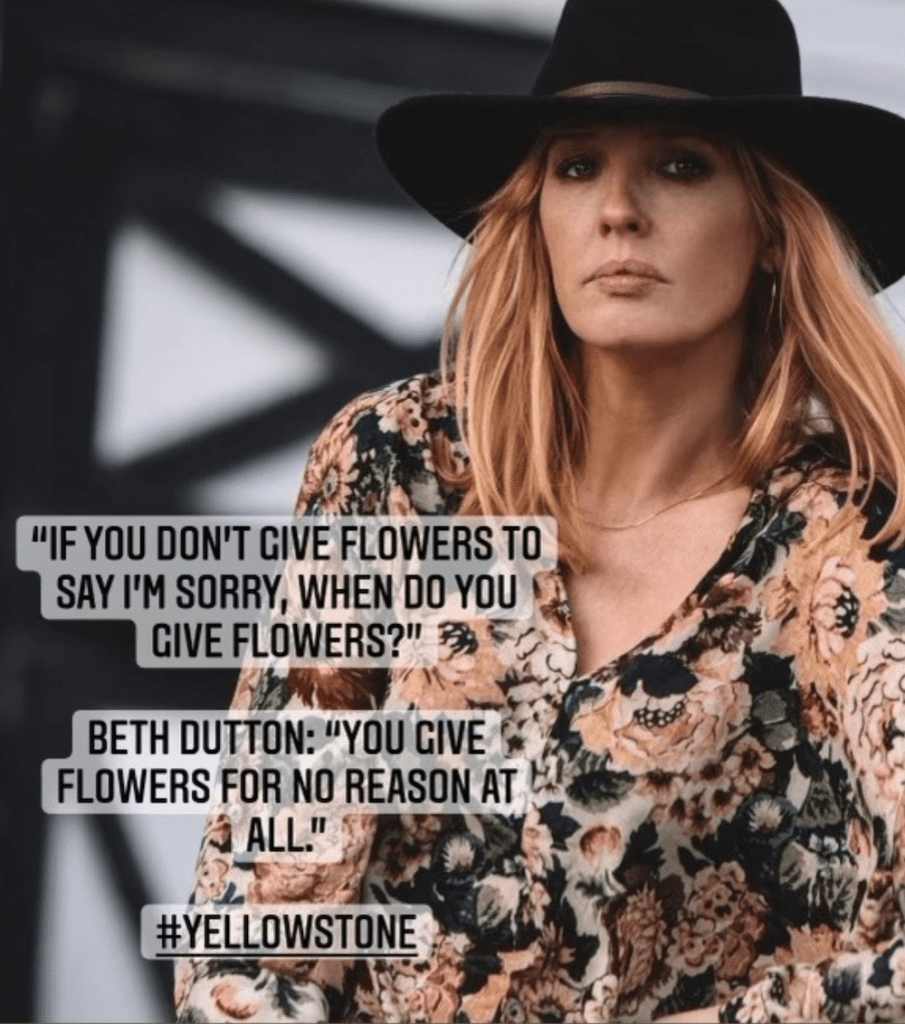In TV’s “Yellowstone,” Montana Landscapes Popular Character
By Jill Brooke

Because the beautiful natural landscapes of Montana are like characters in the hit series, “Yellowstone,” thought I would share some interesting facts about Montana’s state flower and a bit of history for you.
Lewis and Clark discovered the “bitter root” in the western Montana valley, where Montana’s Indians used the bitter root as an important part of their diet – and believed it was protection. The Bitterroot Mountains (which form the divide between Idaho and Montana), the Bitterroot Valley, and the Bitterroot River all owe the origins of their names to this flower.
Indian tribes, which are very much respected in this amazing series which is an ode to cowboy toughness – timed their migrations with the blooming of the bitterroot. One ounce of dried root provided sufficient nourishment for a meal, though it had to be cooked. Pulverized and seasoned with deer fat and moss, the cooked root could be molded into patties and carried on hunting expeditions or war parties.
At major trading centers like The Dalles, the root was an item of barter and exchange. A sackful commanded a substantial price such as a horse.
But it was a woman named Mrs. Mary Long Alderson who advocated for it to become a state flower.
With a strong Indian heritage and a name derived from the leader of the Lewis and Clark expedition, the bitterroot was most appropriate as a state symbol, according to the state’s website. In their contribution to the 1893 Columbia Exposition, Butte residents used the flower as the central figure on a large silver shield. That same year, in response to a national WCTU program, Mrs. Mary Long Alderson of Bozeman began efforts to secure legislative designation for the bitterroot as Montana’s state flower.
Mary Alderson was the heart of the state flower movement in Montana. In January of 1894, she formed and headed Montana’s Floral Emblem Association. County and community committees followed, as did floral meetings in most major cities and towns. The association set a state-wide referendum for fall. Interested men and women registered in their respective counties. Mrs. Alderson’s committee then sent out a ballot to each registrant. Ballots had to be completed and returned by September 1, 1894. What was significant is that anyone – at any age – could vote.
Montana’s press joined in the effort. Editorials advocated this flower or that. When the polls closed, 5,857 ballots were in. More than 32 separate flowers received votes. The winner (with 3,621 votes) was the bitterroot, followed by the evening primrose (787 votes) and the wild rose (668).
Before long the delicate petals of the bitterroot graced stationery, posters, silverware, and even special sets of double damask Irish linen. The major credit for the addition of the bitterroot to Montana’s list of official symbols belongs to Mary Long Alderson.
However, the Indians also had long-held traditions with the flower. Thanks to Kevin Costner’s longtime advocacy, Indian perspectives are very much a part of the series as heroes, along with the Dutton family, in trying to protect the beauty of nature from outsiders wanting to turn it into a ski resort.
While Lewis And Clark are often credited with the discovery of the plant – its scientific name is Lewisia rediviva – the bitterroot was a staple of indigenous tribes, namely the Salish people who lived in the bitterroot’s habitat.
An old Salish story tells how the bitterroot came to be. One winter, there was no game to eat toward the end of the season, so an old grandmother cried for her starving people. The woman went up on a hill to ask the creator for mercy and protection, grieving over the plight of her people. Her tears ran down her silver hair and the sun turned her tears into the bitterroot flower, whose nutritious root provided the starving people with food. So when the bitterroots burst into bloom every spring, we can admire the silvery sheen of the puddles, and remember the old grandmother’s hair and her prayer for her people.
As well as the efforts of Mary Long Alderson in making it Montana’s state flower.
Thanks to the popularity of the show – over 12 million people tuned in to the last episode – interest in Montana has skyrocketed.
Wildflowers are part of the rugged Western decor in the show which educates the public on different styles of dress and design. In fact, one of my favorite characters, Beth Dutton, is always in floral dresses as well. Nature does entertain and inspire.
And we can’t help love her quote she just said when her adopted charge Carter tried to earn her forgiveness with flowers. He asks, “If you don’t give flowers to say you’re sorry, when do you give flowers?” To which she wisely says in her fierce feminine badass way, “You give flowers for no reason at all.” A quote for the ages.

Jill Brooke is a former CNN correspondent, Post columnist and editor-in-chief of Avenue and Travel Savvy magazine. She is an author and the editorial director of FPD and floral editor for aspire design and home magazine and contributor to Florists Review magazine.
